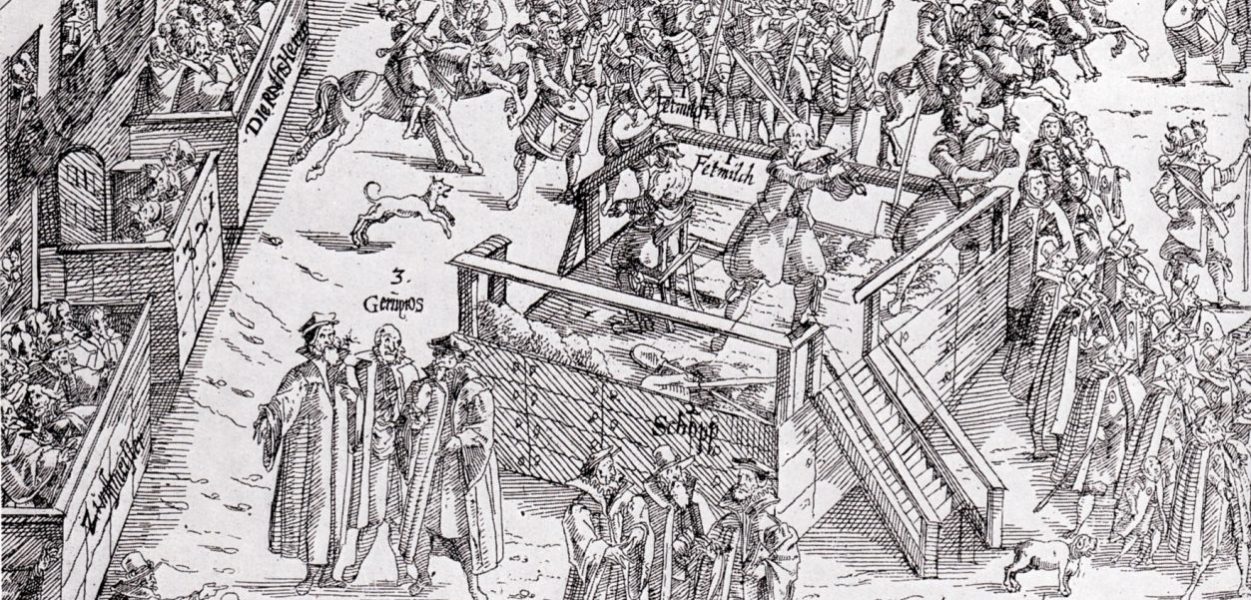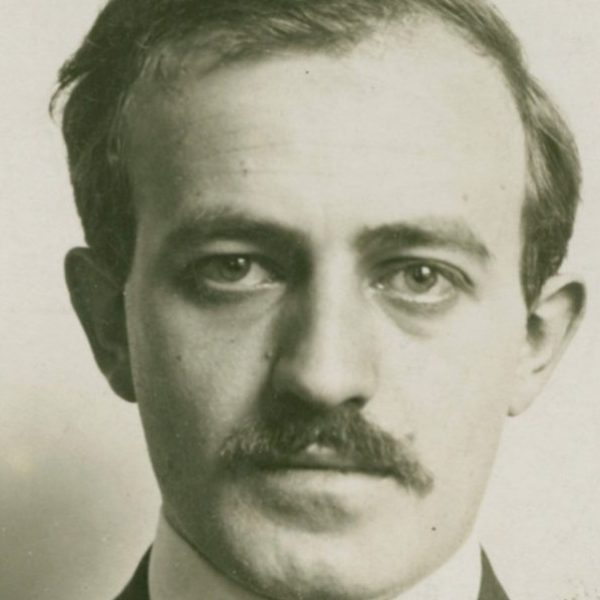The Fettmilch Attack on the Frankfurt Ghetto
Kenneth Austin—
On August 22, 1614, Vincenz Fettmilch, a Calvinist gingerbread-maker, led an attack on Frankfurt’s ghetto, a single street known as the Judengasse (“Jews’ Lane”). When it was first established, the community had about 150 residents; by the early seventeenth century, this number had risen to almost 2,000. Its size had not significantly increased however: instead a second row of houses was built behind the existing ones on both sides of the street, extra floors were added on top, and all this space was divided into increasingly small portions. This was, then, one of the largest Jewish communities in Europe, but also one of the most crowded. Fettmilch’s mob—a motley band of apprentices and other workers with a diverse set of grievances—drove the Jews out of the ghetto into the nearby Jewish cemetery and pillaged their homes; at least one Jew died in the confrontation. The very next day Fettmilch ordered the expulsion of all Jews from the city.
In one sense, this was simply the latest example in a seemingly endless sequence of attacks on Europe’s Jewish inhabitants. During the Middle Ages, the Crusades and the Black Death had prompted widespread attacks on Jewish communities. Likewise, unfounded accusations—most commonly of ritual murder (it was alleged that Jews killed a Christian child) and host desecration (it was claimed they attempted to cause harm to the bread used in Mass)—frequently precipitated retributive action. Expulsions too were common: Jews were expelled from England in 1290, from France in 1306, and, most famously, from Spain in 1492. Frankfurt was located in the Holy Roman Empire, a patchwork of interlocking territories. While individual cities and regions could, and regularly did, expel their Jewish inhabitants, those Jews could often find more welcoming areas nearby (though we should not underestimate the practical and psychological impact of such expulsions or the vulnerability that they highlighted).
It’s clear that the Jews of Frankfurt also were in various respects scapegoats, caught up in a broader conflict that had very little to do with them. Fettmilch’s supporters were principally drawn from the lower ranks, who resented the fact that the city’s government was dominated by a social elite. These class tensions were exacerbated by high rates of taxation and rumors about government corruption. Repeated demands for reform achieved little, and so, in May 1614, rebels seized control of the city. The Jews soon emerged as one of their principal targets. Not only was their sheer number perceived as a threat—they constituted about 10% of the city’s population—but it was also felt that they had exercised too much influence over the government. Beyond this, they were resented because of their roles as moneylenders and pawnbrokers: it was, inevitably, members of the lowest ranks of society who were most dependent on those services and who no doubt saw their financial straits compounded by their dependence on these non-Christian outsiders.
In these respects, the assault on the ghetto of Frankfurt had much in common with medieval attacks on European Jews. But something had happened that made the context also noticeably different: the Reformation. Indeed, in 1614, it was only three years until Lutherans would commemorate the centenary of Martin Luther’s attack on the medieval practice of indulgences of 1517. There were at least three different ways in which the Reformation had an impact on events in Frankfurt. First, the Reformation had brought about a situation of religious pluralism. Although it was ultimately answerable to the Catholic Holy Roman Emperor, Frankfurt was a predominantly Lutheran city, but with Catholic and Calvinist minorities. The uneasy relationship between these groups is hinted at by the local aphorism: “the Lutherans have the power, the Calvinists the money, and the Catholics the churches.” Relations between the two Protestant groups were especially fraught. In 1596, Calvinist worship was banned in the city for a period of five years; in 1608, their church was burned down. Many Calvinists left the city as a result in the period leading up to 1614. These confessional divisions undoubtedly contributed to the tensions that precipitated the attack on the ghetto.
More than that, the Reformation had given new attention to the place of Jews in Christian society. At its root, the Reformations—Protestant and Catholic—had sought to address the questions of how a Christian should behave and how a Christian community should be organized. In that endeavor, Jews—ancient and contemporary—were a significant point of reference. Scholars and reformers in each Christian community were keen to understand as fully as possible the context in which the bible had been written: this had, for instance, given a new impetus to the study of Hebrew and of Jewish culture. Indeed, it is particularly striking that the provocation for the temporary ban on Calvinism in Frankfurt was the publication by the distinguished Wechel press of a Latin edition of the bible produced by Franciscus Junius and the convert from Judaism Immanuel Tremellius, a work that embodied this endeavor.
Finally, in order to stir up anti-Jewish sentiment in the city, Fettmilch had, in 1612, two years before the assault on the ghetto, arranged for the publication of a new edition of Martin Luther’s On the Jews and their Lies, the most notorious and objectionable writing by a Protestant reformer to emerge from the Reformation. Whereas earlier in his career Luther had recommended the benign treatment of Jews who lived among Christians, in the hope that this would lead to their conversion to Christianity, by 1543, when he wrote this later work, he had given up entirely on that idea. Instead he undermined various claims that he said Jews made about themselves, berated them for their failure to acknowledge what he felt was the self-evident truth of Christianity, and advised political leaders to subject the Jews in their territories to a range of persecutory and humiliating measures. There is a particular irony that Fettmilch, at least ostensibly a Calvinist, should turn to this Lutheran text to advance his anti-Jewish agenda.
In the event, it was the Catholic authorities who restored order. Matthias, the Holy Roman Emperor, declared Fettmilch and his supporters outlaws. In September, the elector of Mainz and the Landgrave of Hesse-Darmstadt sent in troops to Frankfurt to enforce his judgment. The citizens immediately turned against Fettmilch, who was arrested, along with a number of his principal supporters. On February 28, 1616, eighteen months after the attack on the ghetto, Fettmilch and several of his accomplices were executed; the heads of Fettmilch and three others were placed on spikes on top of one of the city’s gate-towers, while his house was razed to the ground. On the same day, the Jewish population was readmitted to Frankfurt, accompanied back to their ghetto by a Christian population that expressed regret that it had ever moved against them. Their triumph, though, was in some ways short lived. Only two years later, the Thirty Years War (1618–48), another product of the religious tensions provoked by the Reformation, would break out, and once again the Jews of Frankfurt would become collateral damage, victims of a conflict in which they had no interest.
Kenneth Austin is a senior lecturer in early modern history at the University of Bristol, UK, and the author of From Judaism to Calvinism: The Life and Writings of Immanuel Tremellius.
Further Reading:



























